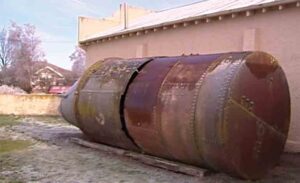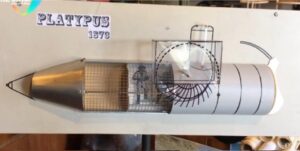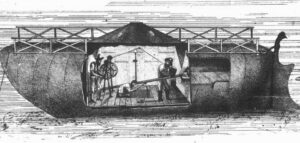1873: The Platypus
December 14, 2022
By AHNZ
Today in New Zealand history, 14 December, 1873, the first and last domestic-built submarine was launched in Dunedin.
The Platypus carried a crew of eight and was part of a cunning plan to get the Otago gold from lake floors. New Zealand was in one of its very impressive industrial ingenuity phases. Actually, at the end of one.
Unfortunately the next historical phase involved a huge bust and the New Zealand Submarine Gold Mining Co was toppled, scuttling its submarine venture. If things had gone another way then New Zealand might have had as many gold submarines as we had gold dredges right up to the mid-20th century. That would have been a fascinating alternative New Zealand history to live in but it wasn’t to be.
Our economy was in big trouble in 1873. The Maori Wars were done and so was the artificial stimulus of the British Army were had been getting wealthy by servicing. Agricultural prices fell thanks to the demand-side shock. The gold rushes were done. Immigration down, emigration was up. It was time for those sticking with New Zealand to retrench, re-balance, and re-organise and that’s the sort of smart decision many generations would have made. However, along came Julius Vogel with a debt-based stimulus plan and a foolish generation AHNZ calls the Vogel Boomers who were stupid enough to follow him. The band-aid on the cancer was called the Mini-Boom but of course it didn’t prevent the recession we had to have it only turned it into what is called the Long Depression.
The old power brokers toppled like the dinosaurs of old, including crippled Vogel who abandoned the country he ruined. The NZ Submarine Gold Mining Co. was a fatality of these times of crisis. It would take a long time, over a decade, for New Zealand to recover from the Long Depression and gold submarines were a casualty of the mass extinction. Out of the re-balancing our economy had to have but which had been resisted, perverted, constipated, Vogelled, came new winners. New men led the way such as John Grigg, Bendix Hallenstein, and Henry Shacklock. Ref. 1873: I Am Iron Man, AHNZ
Proof of Concept

We never run out of natural resources because we stop when the effort of collecting them is exceeded by the rewards. This happens long before there is nothing left to extract. New Zealand’s first, and last, submarine was an answer to this problem. The gold that could be mined by the old conventional and labour-intensive methods had been mined by the late 1860s so we had to become more productive and that required an increase in capital investment. Now came the era of the gold dredge and the gold submarine: The Platypus.
Investment banker, specialising in the goldfields, Reginald William Nuttall was the vision behind the Platypus. Returning from a trip to Australia with his wife (Sophia, eldest illegitimate daughter of General Trevor Chute,) Nuttall sprang a scheme to get at the underwater gold. Using his gift of the gab (“He is a splendid talkist, if you like,”) engineering patents, and financing skills he issued a propectus and issued shares in the New Zealand Rivers Gold Mining Company. He also had the inventor, Messrs Villaine.
Nuttall appears to have sold out, passing the project and the engineer on to a new firm called New Zealand Submarine Gold Mining Co. By 1875 Nutall and family had left for America where he became a “big thing in railways.”¹ On 14 December, 1873, the gold submarine was ready for testing. As unique as it was, constructing a metal submarine was no problem for the heavy engineering expertise honed by the gold rushes at Dunedin. It was not fully submerged but Platypus took 4 or 8 men to the bottom of Dunedin’s inner harbour at the Rattray Street wharf. It was sent on the way by an excited crowd of spectators, christened with champagne, and decorated with flags.
Now the sub had established proof of concept more trials were conducted. Most sources say 8 men were used on the first attempt but one of the self-identified New Zealand submariners later said there were only 4 and named each. Also, contemporary claims state only 2 dives were made but the correspondent from 1924 remembers several.
“With the chance to view a possible revolution in mining without having to pay for it, the canny Scots of Dunedin thronged the Rattray Street wharf of the city’s inner harbour on December 1873 to watch the first test of the odd-looking submarine….Slowly it sank to the bottom of the harbour and to acclaim from the spectators and, of course, the investor, it rose once again to the surface.” – The first and last Kiwi submarine,
“The vessel was commenced by “the late firm of Messrs Sparrow and Thomas, and completed by Messrs Sparrow- and Co., of the Dunedin Ironworks, and Messrs Fraser, “Wishart, and Buchanan, of the Railway Foundry.” The Platypus was christened with flags flying, and a bottle of champagne was broken on her bow. “A few venturesome individuals were launched with the craft, and loudly their cheers rang out when she took the water fairly and did not turn turtle, but, on the contrary, floated as buoyantly and as upright as a dish.”” – AN HISTORICAL NOVELTY. A PIONEER SUBMARINE IN OTAGO HARBOUR, Otago Witness (1924,) Papers Past
“Your article states that six or eight men went clown in the boat at its first trial, which took place on a Saturday afternoon. If I am not mistaken, only four persons formed the party to descend—viz., Mr Douglas, Mr Villane, Mr Harvey (Government inspector), and myself (representing Mr William Oram Ball, the secretary to the company). The article is perfectly correct about the first trial. We went clown, and remained there for several hours on account of some defect in tho machinery. Tho bottom of the boat was taken off, and I obtained several things from the bed of the bay. This defect was repaired on the Monday, when there was another trial, the same four forming the party. This trial proved perfectly successful. We were able to descend and rise several times.” – D. K. Rhodes, Otago Witness (1924,) Papers Past
The idea was not to use the sub in Otago Harbour to pick up mud, shell, and fishing lines but to go to gold-bearing rivers such as the Clutha and Kawarau. It was designed that the current would power the submarine’s life support system so men wouldn’t have to work the air pumps. Potentially it could have powered an electric light too if they had the technology but I’m sure they had gas lanterns aboard long perfected in gold and coal mining.
Dead in the Water
 The most spectacular trial of the Platypus came on 2 February, 1874. It was an unqualified success with total submergence and controlled resurfacing over the course of one hour. She was ready to go and get the gold! However, where the hardware was holding its end up the financial sector was dropping through the floor. The artificial stimulus drugs Vogel had been pumping into the New Zealand economy were creating the nasty hangover of the Long Depression. New Zealand Submarine Gold Mining Co. fell into insolvency in April of 1874. The company was dismembered and sold off for parts.
The most spectacular trial of the Platypus came on 2 February, 1874. It was an unqualified success with total submergence and controlled resurfacing over the course of one hour. She was ready to go and get the gold! However, where the hardware was holding its end up the financial sector was dropping through the floor. The artificial stimulus drugs Vogel had been pumping into the New Zealand economy were creating the nasty hangover of the Long Depression. New Zealand Submarine Gold Mining Co. fell into insolvency in April of 1874. The company was dismembered and sold off for parts.
Although, according to Pete Sparrow’s oral history (ODT, 2019) a last dive went wrong to the point where the crew dispatched a note to the surface reading “We are prepared to meet our maker.” There are always kinks to work out with new tech.
“A further trial was carried out on 4 February and declared an unqualified success. The Platypus submerged and took 45 minutes to reach bottom; after a few minutes the bottom hatch was opened and there was no difficulty with keeping water out. Shells were collected off the bottom, also a fishing line and seabed mud. The bottom hatch was closed and there was no problem with expelling water to raise the sub from the bottom. The ascent took 14 minutes. The jubilant crew emerged hailing the dive a success.” – The Platypus, Dive New Zealand (2015,) Wayback Machine
“The Platypus had its maiden voyage in Otago Harbour just three years after Jules Verne released the underwater science fiction classic 20,000 Leagues Under the Sea in 1870.” – Beached as: Super-rare 1870s submarine washes up in landlocked Otago town, Stuff (2019)
“Despite the successful trialing of the submarine, the New Zealand Submarine Gold Mining Co fell into insolvency in April of 1874 and the submarine with its patent rights was auctioned off in Dunedin. They were purchased for $800 and the sub stripped of its fittings. The Platypus never sailed again.” – Dive New Zealand (2015)
Platypus was abandoned on the side of Lake Logan, from 1874 until it was removed due to the arrival of the South Seas Exhibition in 1924. At about the same time it was the subject of a local heritage talk which led to an audience member buying it and shipping it to Central Otago for parts. The bow and stern sections were donated to the Middlemarch Museum by a local in 1991 but the central part seems to be long gone.
Apparently Middlemarch Museum need to raise tens of thousands of dollars to protect and preserve the sub. I’m skeptical of that the same way I am about the Opepe Canoe. Both the Maori Canoe and the Otago Submarine managed just fine for over a century of neglect but now suddenly they need a king’s ransom spent on them? Not to mention the Invercargill Athena which also had to be massively funded for unspecified preservation work. ‘Immediate Preservation Required’ must be some kind of magic words museum curators say to get government grant distributors to open their (ours, actually) wallets.
New Zealand is fortunate to have this one gold submarine. We also have one gold dredge left on the West Coast although back in the day there were many of these working and re-working the sites raw labor power once toiled for gold. Allan Birchfield’s dredge at Ngahere could be earning money for New Zealand but The State wont let it operate. Ref. Unique West Coast gold dredge for sale, Stuff (2016) This one may yet rise again as the battle is ongoing and made the newspapers again as recently as December 2022. A dredge is much harder to incorporate into a museum though so it may as well be earning its keep.
—
1 NEW ZEALAND IN SAN FRANCISCO, North Otago Times(1875;) Papers Past
Image ref. Sketch of Platypus, Otago Witness, Otago Daily Times (2019)
Image ref. Platypus remains at Middlemarch Museum, Quarrying and Mining Magazine (2017,) Wayback Machine
Image ref. Platypus model shown to OTD (2019)
Ref. 1920s sketch by H. M Davy based on descriptions given to him, Otago Witness (1924;) Papers Past
Ref. General Chute’s illegitimate wife and children, THE KERRY BULL’S CALVES, The Family Mess (2020)
One thought on "1873: The Platypus"
Leave a Reply
 Like Comment Share
Like Comment Share







I’ve been to the museum at Middlemarch but I didn’t know that was there